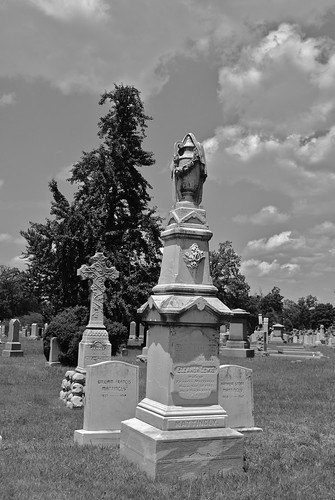Photo of a different local cemetery (Glenwood)
I saw a WTOP article (DC cemetery uses science to fight pollution) that caught my eye the other day about efforts at Mount Olivet Cemetery (1300 Bladensburg Road NE) to reduce runoff pollution in local waterways, such as the Anacostia River, by replacing some paved surfaces with native plant rain gardens that can retain water instead of sending into our aging combined sewer system. The article says "[i]t’s the first time science and technology is being used at a cemetery to take on pollution." It made me curious enough to do a bit of additional research that I wanted to share.
Mount Olivet Cemetery is the largest Catholic cemetery in the District, and was established in 1858. According to a Washington Post article I read (The secret life of cemeteries: Go for a stroll, meet your book club, visit the dead) it was also one of the first cemeteries in the District to be racially integrated.
The runoff reduction efforts are a project between the local chapter of the The Nature Conservancy (TNC) and the Catholic Archdiocese of Washington. A press release posted on The Nature Conservancy's website in November of last year offers more details (The Nature Conservancy and Catholic Archdiocese collaborate on stormwater retention project at historic Mount Olivet Cemetery). It states that "[o]ver three billion gallons of stormwater run-off and sewage flow into D.C.’s local rivers each year, making it the fastest growing source of water pollution both in the Chesapeake Bay and worldwide." Stormwater from "Mount Olivet Cemetery drains directly into Hickey Run, one of the Anacostia River’s most impaired tributaries and a restoration priority for the District."
It's a really interesting story and project. A piece published in Chesapeake Bay Magazine this February, Historic D.C. Cemetery Digs Up Pavement to Stop Stormwater Runoff, has more details on how it all happened. Remember seeing a bunch of news coverage about how DC Water's Clean Rivers Impervious Area Charge caught some people and institutions (including some local churches) off guard?
The fee is meant to offset the cost of the giant retention tunnels the utility is constructing, The District's cemeteries suffered a bit of sticker shock too. According to the Chesapeake Bay Magazine article, Mount Olivet Cemetery's bill, which had been "less than $7,000 before the fee was added in 2009, rose to nearly $140,000 [for the fee] in 2017." The fee was so high because it encompassed over "435,000 square feet of impervious surfaces" in the cemetery. Rarely used access roads apparently made up a fair bit of that acreage. It was at this point that The Nature Conservancy entered the story, and the parties began to form a plan for what would become a demonstration project that could be replicated elsewhere through TNC's Cities program.
TNC's press release explains that they conducted a thorough analysis, including the use of ground penetrating radar, accounting for topography, soil composition, and layout before commencing work "replacing or retrofitting [selected] impervious surfaces...with water-retaining green infrastructure such as, grass, flower beds, shrubs and trees." Through careful planning they were able to ensure that no graves would be disturbed,"and construction would not disrupt scheduled burials or impede the ability of people coming to visit loved ones buried at the cemetery." For its efforts, the cemetery will receive Stormwater Retention Credits (SRC) that it can sell.
Aside from the stormwater remediation work, TNC teamed up with Casey Trees to plant over 150 new trees at the cemetery, and is working with the TKF Foundation "to install a commemorative, native pollinator garden and bench." Combined, "[t]hese projects will provide habitat for wildlife, water filtration benefits, and shade and places of rest for visitors."
The Nature Conservancy has even uploaded a cool video about the project.

2 comments:
Thanks for your extremely interesting report, Inked! This really is very interesting (...also, some very good writing on your part). This reminded me of when the Congressional Cemetery hired(?) a bunch of goats to de-weed the joint. (See what I did there?). I recently had to contest a surcharge that DC put on my house for a 'paved backyard'. I had been paying this odd fee without realizing it, before the cost came to my attention upon further scrutiny of my bill. My place used to be a church, and the backyard was paved back then. During the reno, the tar was replaced with what now amounts to crabgrass and a few blotches of what one might call real grass (I did it again!). I had to take pictures and send to DC gov, and unbelievably, they refunded the amount that I had been paying over the last several years. I'm heartened to hear that some people find the issue at hand in your reporting to be significant. There's a multi-year effort to make the Anacostia swimmable again. All of these efforts are a boost to the overall liveability and well being of our little town. Wow. Again, really nice write up!!
Poo,
You’re making me blush. This one did take a bit of time to put together (hence a day of no posting), but I found it to be a really interesting topic and felt sure others would be intrigued as well. There’s definitely a lot more out there for anyone inclined to do their own research. Hopefully the links (including that great Chesapeake Bay Magazine article) will point the curious in good directions.
Post a Comment